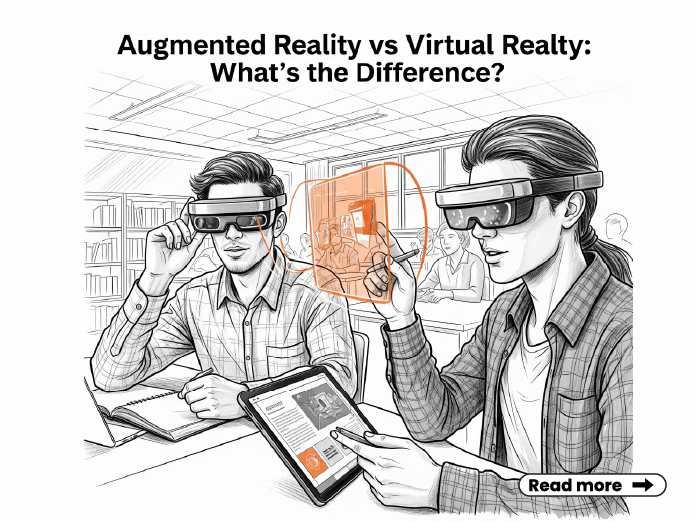Technology is changing the way we live, work, and learn. Among the biggest game-changers are immersive technologies like Augmented Reality (AR) and Virtual Reality (VR). These tools are no longer just part of science fiction. They are now reshaping industries like entertainment, education, healthcare, and retail.
However, people often confuse AR with VR. While both belong to the same family of immersive tech, they are quite different in how they work and what they offer.
This blog explores the difference between augmented reality vs virtual reality, their applications, and how students can build a career in this fast-growing field.
What is Augmented Reality (AR)?
Augmented Reality (AR) blends digital content with the real world. It does not replace your surroundings. Instead, it adds digital elements to them. You still see and interact with the real environment, but with an extra digital layer.
You’ve likely used AR without even realising it. Think of Snapchat filters, where your face turns into a cartoon or animal. Google Lens is another example, where your camera scans text, objects, or places for instant results.
AR shopping apps let you see how a sofa would look in your living room. These are popular AR experiences that blend digital fun with reality.
AR is not just for fun. It is also making waves in classrooms and labs. AR in education helps students understand tough concepts with 3D models, interactive visuals, and real-time feedback. When comparing AR vs VR, AR is more accessible because it needs only a smartphone or a tablet.
What is Virtual Reality (VR)?
Virtual Reality (VR) is all about complete immersion. It takes you into a fully digital environment that replaces your physical world. To enter this space, you need VR headsets like Oculus Rift, HTC Vive, or PlayStation VR.
Once inside, you can explore 3D worlds, play games, or even practise surgeries—all in a simulated setup. VR gaming is a leading use case. You move, look around, and interact with the digital world using controllers. In training and education, VR helps professionals learn in a safe, controlled setting.
Unlike AR, VR blocks out your surroundings. It creates a brand-new space for learning, playing, or working. That’s why it is so popular for simulations and skill-based training.
Key Differences Between AR and VR
| Feature | Augmented Reality (AR) | Virtual Reality (VR) |
| Environment | Real world with digital overlay | Fully simulated digital world |
| Equipment Needed | Smartphone, AR glasses | VR headsets and controllers |
| Interaction | Enhances real-time experience | Replaces the physical environment |
| Use Cases | Retail, education, and healthcare | Gaming, training, and virtual tours |
As shown above, the augmented reality vs virtual reality comparison shows that AR complements reality while VR replaces it. Both offer unique ways to experience digital content, but suit different needs.
Extended Reality (XR): The Bigger Picture
Now that we understand AR and VR, it’s time to look at XR (Extended Reality). XR is the umbrella term that includes AR, VR, and MR (Mixed Reality).
While AR adds to the real world and VR creates a new one, Mixed Reality (MR) allows real and virtual elements to interact. Think of it as the best of both worlds. XR is being used in design, defence, education, and enterprise-level training. It supports everything from virtual prototyping to interactive learning.
XR technology is the future of how we will engage with content and experiences.
Applications of AR and VR in India
India is seeing a surge in AR and VR applications. In schools, AR in education helps make lessons more engaging. Imagine learning anatomy through 3D models that pop up on your desk. Museums use AR to bring exhibits to life. Skill development centres use it to train workers with real-world tasks in a digital space.
VR gaming is growing too. Gaming zones and arcades are investing in VR for deeper user engagement. Hospitals and medical colleges are using VR for surgical training. This ensures doctors get hands-on experience without any risk.
Training centres for manufacturing, defence, and aviation also use VR to teach complex tasks in a controlled setting. This makes learning quicker, safer, and more effective.
Career Scope in AR and VR
As immersive tech grows, so do job opportunities. Here are some exciting roles in this space:
- XR Developer
- UI/UX Designer (Immersive Tech)
- 3D Artist or Animator
- Interaction Designer
- AR/VR Tester and Quality Analyst
Industries hiring AR/VR professionals include:
- Gaming and Entertainment
- Education Technology (EdTech)
- Healthcare
- Architecture and Real Estate
- Advertising and Marketing
This field combines creativity with technical skills. It’s ideal for students who enjoy coding, design, or storytelling.
Academic Pathways: How to Build a Career in AR/VR
To succeed in AR/VR, students need a mix of design, coding, and problem-solving skills. Core areas include programming, 3D modelling, game development, user experience (UX), and spatial computing.
Programmes at Lovely Professional University (LPU)
LPU’s B.Tech in CSE (AI & Robotics) gives students a solid foundation in advanced tech like AI and robotics. It also includes spatial computing and intelligent systems, which are vital for AR/VR development. Students get hands-on training in AR/VR labs, building real-world applications.
LPU’s B.Design Course (Multimedia/Interaction Design) focuses on immersive experiences. It covers UX design, motion graphics, 3D visualisation, and interaction design. Students also work on live AR/VR projects, building a strong portfolio.
“Whether you’re passionate about designing immersive environments or coding next-gen experiences, LPU’s AR/VR-focused programmes equip you for success in this futuristic field.”
Conclusion
Augmented Reality vs Virtual Reality, they may sound similar, but they serve different purposes. AR adds digital layers to the real world, while VR takes you into a fully virtual one. Together, they form the foundation of immersive tech.
As industries adopt AR and VR, skilled professionals are in demand. Choosing the right course can help you join this revolution. With expert-led programmes and modern labs, Lovely Professional University prepares students for exciting careers in AR/VR.
FAQs
Q1: Which is better for gaming, AR or VR?
VR offers a more immersive gaming experience. You feel like you’re inside the game. AR adds fun elements to real-world play but is less immersive.
Q2: Can AR and VR be combined?
Yes. Mixed Reality (MR) combines both. It lets users interact with digital and real elements together.
Q3: What are the best courses for learning AR/VR?
Courses in computer science, multimedia design, game development, and interaction design are ideal. LPU offers top-rated programmes in these areas.
Q4: Does LPU offer AR/VR-focused programmes?
Yes. LPU offers B.Tech in CSE (AI & Robotics) and B.Design (Multimedia/Interaction Design). Both include AR/VR training.
Q5: What are career options in immersive technologies?
You can become an XR Developer, 3D Artist, Interaction Designer, or UX Specialist. These roles are in demand across gaming, education, healthcare, and tech firms.














